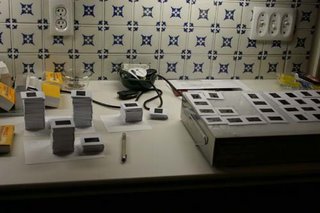
There are still schools, universities, colleges, residencies, gallery shows, competitions, awards, all sorts of things that require work submitted as slides. It really is stupid.
Kodak does not make slide projectors any more.
It seems that nearly everyone has a computer now. Or at least I don't know of anyone who actually owns a slide projector who does not also own a computer.
AND the wonderful things that can be done with digital media projectors is absolutely amazing!
What is especiallly confusing, is that ANY school still requires the submission of work in slide format, especially when most of the visiting artist presentations are given using a computer and a digital media projector.
Slides are expensive!!! I could mail you 20 slides and it would cost me about $10 for the mailing, about $20 for the slides (and it's about twice as much if I have to get duplicates made instead of just using the first run of photos...).
OR, I could mail you 20 images (or more) on a CD/DVD for about $2 (one buck for the disk, another dollar for the envelope and stamp)

The art world at large, especially the academic art world, is further isolating itself from the greater world. If an artist does not care to share his/her work with others, then this point is moot. But, many artists are fooling themselves into thinking that they don't really care to have others see their work. 1% of the artists who say that are telling the truth, and 99% are complete liars!
Artists have almost always had a difficult time justifying their passion for art. "What good is art anyway? It's just decoration." is kind of an all too common comment. The continuous insistence on the use of slide just adds fuel to the fire by helping keep the art world seperated from the rest of the world. And, indeed, art becomes useless because it becomes invisible as it falls behind in the use of technology.
Additionally frustating is the large amount of artists using non-traditional media. Their work is happily accepted in digital format. So, then why must drawings, paintings, and sculpture be presented on slides?
Wouldn't a sculpture be better represented with a video? Video could be transferred to a DVD.
Do you really want to see 20 slides of a performance piece? Or, would you prefer to have a more complete sense of the work by viewing a DVD?
Universities have media projectors that can mimick slide projectors.
Let's take some of the expense out of sharing our art with the world. Allow us to use digital representation, so that artists' money can be spent on more important things, like creative materials (or rent, food, medical insurance)

















